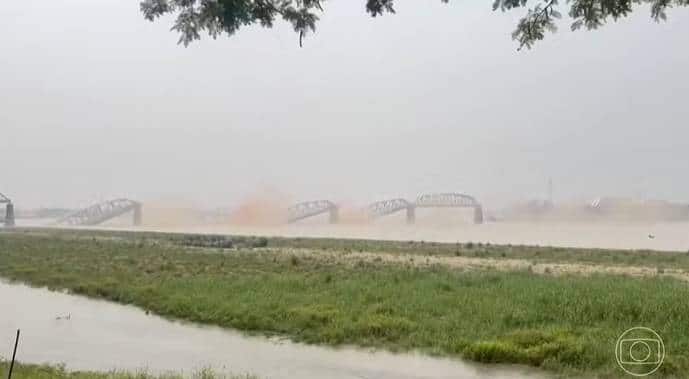A massive earthquake of magnitude 7.7 struck Southeast Asia on Friday, March 28, unleashing widespread destruction across Myanmar, Thailand, and parts of China. The epicenter, located just 16 kilometers northwest of Mandalay, Myanmar’s second-largest city, occurred at a shallow depth of 10 kilometers, amplifying the tremor’s intensity in heavily populated areas. Initial reports indicate over 1,000 fatalities in Myanmar, while in Thailand, rescue teams are searching for 117 people missing beneath the rubble of a collapsed skyscraper in Bangkok. The quake, felt hundreds of kilometers away, exposed regional infrastructure vulnerabilities and prompted urgent international relief efforts.
In Myanmar, the toll was catastrophic, with state television reporting 1,002 deaths and 2,376 injuries as of the latest updates. Buildings crumbled in cities like Mandalay and Naypyitaw, the capital, while roads split open and historic bridges, such as the Ava Bridge, collapsed under the quake’s force. In Thailand, the collapse of a 30-story skyscraper under construction in Bangkok claimed at least nine lives and left dozens of workers buried, highlighting the fragility of structures in a region unaccustomed to such seismic events. China, though less severely hit, reported damage to homes in Yunnan province near the Myanmar border.
Amid the chaos, Myanmar’s military junta, in power since 2021, declared a state of emergency across six regions and issued a rare call for global assistance. The quake, followed by a 6.4-magnitude aftershock, deepened the crisis in a nation already strained by internal conflict and recent natural disasters. In Thailand, Prime Minister Paetongtarn Shinawatra declared an emergency in Bangkok, where shocking footage showed rooftop pool water cascading like waterfalls and buildings swaying, sparking widespread panic among residents and tourists.
Myanmar faces catastrophic destruction
Mandalay, home to roughly 1.5 million people, is a scene of utter devastation. Five-story buildings collapsed in front of stunned onlookers, who described streets clogged with debris and residents too terrified to return home. A local resident reported that the Sein Pan neighborhood caught fire after structures gave way, while phone lines and electricity were severed, hampering communication. Hospitals like Mandalay General were overwhelmed, with the injured treated in parking lots and on streets, many still hooked to IV drips and oxygen tanks amid chaotic conditions.
Naypyitaw, the capital, also bore the brunt of the disaster. Roads display massive fissures, and the National Museum suffered cracks in its walls, with sections of the ceiling caving in. The Emergency Department at Naypyitaw General Hospital resembled a war zone, with patients on makeshift stretchers and cries of pain echoing through the facility. Junta leader Min Aung Hlaing visited the hospital, calling for blood donations—a sign of the crisis’s severity in a country where healthcare is already stretched thin by civil war and economic hardship.
The Sagaing region, near the epicenter, saw extensive damage as well. The Ava Bridge, a 90-year-old historical landmark, fell apart, cutting off communities and complicating rescue operations. Smaller villages reported homes reduced to rubble, with survivors forced to dig through debris by hand due to a lack of heavy machinery. The U.S. Geological Survey warned of soil liquefaction risks, a phenomenon that could turn waterlogged ground into mush, worsening damage to buildings and raising the threat of landslides in mountainous areas.
Bangkok reels from skyscraper collapse and street panic
Thailand’s capital, unprepared for seismic shocks, faced its own nightmare. A 30-story skyscraper under construction in the Chatuchak district collapsed during working hours, trapping over 300 workers on-site. At least nine deaths have been confirmed, with 117 still missing as rescue teams work tirelessly to locate survivors. Defense Minister Phumtham Wechayachai reported that around 50 injured individuals were rushed to hospitals, many in critical condition.
Dramatic footage captured the skyscraper’s fall, with a dust cloud swallowing nearby streets close to the popular Chatuchak Market. Social media videos showed water spilling from a hotel rooftop pool and residents fleeing high-rises in terror. The BTS Skytrain and MRT subway systems shut down for safety checks, paralyzing Bangkok’s traffic and stranding thousands amid fears of aftershocks. Prime Minister Shinawatra urged people to avoid tall buildings but later assured the public that the situation was stabilizing, allowing cautious returns home.
Northern Thailand, including Chiang Mai, reported cracked temples and homes but no fatalities so far. Experts note that Thailand, outside typical seismic zones, lacks building codes designed for such quakes, explaining the concentrated damage in Bangkok. The Chatuchak skyscraper collapse underscored this gap, as construction standards failed to withstand the 7.7-magnitude force felt across the region.
- Key impacts in Bangkok:
- Skyscraper collapse leaves 117 missing.
- Nine confirmed deaths and 50 injured hospitalized.
- Public transport halted, high-rises evacuated.
China feels tremors with minor border damage
China experienced milder effects, primarily in its southern provinces. In Yunnan, near Myanmar, residents reported shaking that toppled roofs and shattered windows in towns like Ruili. Two people were injured, but no deaths occurred. In Mangshi, about 100 kilometers from Ruili, the quake was strong enough to knock people off their feet. The China Railway Kunming Bureau halted five passenger trains as a precaution, though no rail damage was found.
Beijing responded swiftly, dispatching over 135 rescue experts and medical supplies to Myanmar, alongside a $13.8 million emergency aid pledge. China’s proximity and ties with Myanmar’s junta positioned it as a key player in relief efforts, joined by India and Russia in offering support. Social media users in Yunnan and Guangxi shared clips of swaying chandeliers and falling objects, illustrating the quake’s broad reach.
Shallow depth amplifies regional devastation
The quake’s 10-kilometer depth explains its destructive power. Experts say shallow earthquakes release energy directly at the surface, causing greater harm in populated areas. In Myanmar, the Sagaing Fault, running through the country’s center between the Indian and Eurasian tectonic plates, is a known seismic hotspot, though quakes of this scale are uncommon. The last major event in 1956 caused significant damage, but today’s weaker infrastructure and urban sprawl worsened the outcome.
Thailand’s lack of seismic-resistant construction proved costly in Bangkok. A 7.7-magnitude quake, per the Richter scale, is classified as “major” and capable of leveling populated areas, especially at shallow depths. Aftershocks, including a 6.4-magnitude jolt 12 minutes later, continue to threaten weakened structures, keeping officials on edge for further collapses and landslides.
The U.S. Geological Survey estimates that soil liquefaction could affect over 1,000 square kilometers in Myanmar, destabilizing foundations and heightening landslide risks in the Golden Triangle’s hills. In Bangkok, the absence of quake-ready design turned the skyscraper collapse into a stark symbol of the disaster’s unpredictability.
Timeline of recent seismic events in Myanmar
Myanmar is no stranger to earthquakes, but the March 28 event stands out for its scale. The Sagaing Fault has a history of activity. Here’s a chronology of key incidents:
- 1930-1956: Six quakes of magnitude 7 or higher hit central Myanmar, damaging villages and towns.
- November 2012: A 6.8 tremor killed 26 and injured hundreds in Sagaing.
- 2016: A 6.8 quake in Bagan destroyed historic temples, leaving three dead.
- March 28, 2025: Magnitude 7.7 claims over 1,000 lives, the deadliest in nearly 80 years.
This pattern reflects Myanmar’s tectonic position, but the infrequency of such intense quakes caught authorities off guard. Researchers had warned of pent-up energy along the Sagaing Fault, dormant for roughly 200 years, which erupted in this disaster.
Rescue efforts battle mounting challenges
Rescue operations in Myanmar face steep obstacles. The civil war, sparked by the 2021 coup, displaced over 3.5 million people and left 15 million facing food insecurity before the quake. Naypyitaw International Airport sustained damage, with its control tower leaning and inoperable, slowing aid arrivals. Local teams in Mandalay report a shortage of heavy equipment, forcing volunteers to dig by hand at sites like the 12-story Sky Villa Condominium, which collapsed entirely.
In Thailand, Bangkok’s rescue mission has more resources but struggles with the skyscraper’s scale. Families like Naruemol Thonglek’s wait anxiously for news, while survivors recount desperate moments during the quake. Prime Minister Shinawatra oversees efforts, prioritizing the 117 missing, many possibly trapped in elevators or under concrete slabs. China’s team landed in Mandalay with generators and medical supplies, easing pressure on overwhelmed hospitals.
Myanmar’s junta, in a rare move, invited global aid, admitting its inability to cope alone. India, Russia, and the European Union pledged support, while the UN deployed assessment teams. Yet, internet censorship and power outages—common junta tactics—now hinder coordination, delaying food, shelter, and medical aid to thousands of displaced survivors.
Historic and cultural losses mount
Beyond human tolls, the quake threatens Myanmar’s cultural heritage. In Mandalay, a former royal capital and Buddhist hub, ancient temples and pagodas suffered irreparable harm. The Mandalay Palace lost part of its wall, and the city’s clock tower fell, erasing historical landmarks. In Naypyitaw, religious shrines collapsed, deepening local grief over lost sacred sites.
Thailand saw fewer cultural losses, but modern construction safety is now under scrutiny. Mandalay’s Great Wall Hotel, a visitor landmark, sustained deep cracks in its exterior. The Ava Bridge’s collapse, beyond its historical value, severed community links, worsening isolation in a region battered by decades of instability.
The quake laid bare a region of contrasts: Myanmar’s crumbling infrastructure and authoritarian rule, Thailand’s tourism-driven economy unprepared for seismic shocks, and China’s limited damage but swift response. As casualty numbers rise and rescues continue, the disaster’s full scope emerges, signaling a recovery that could take years.
Key facts from the Southeast Asia quake
Critical data underscores the event’s severity across borders:
- Magnitude 7.7, epicenter 16 km from Mandalay, 10 km deep.
- Over 1,002 dead, 2,376 injured in Myanmar per state TV.
- Nine dead, 117 missing in Bangkok skyscraper collapse.
- 6.4-magnitude aftershock and multiple smaller tremors.
- Yunnan, China, reports two injured and damaged homes.
This shallow quake, paired with vulnerable infrastructure and limited crisis response, ranks it among the deadliest in Southeast Asia’s recent history, with effects echoing far beyond Myanmar’s borders.

A massive earthquake of magnitude 7.7 struck Southeast Asia on Friday, March 28, unleashing widespread destruction across Myanmar, Thailand, and parts of China. The epicenter, located just 16 kilometers northwest of Mandalay, Myanmar’s second-largest city, occurred at a shallow depth of 10 kilometers, amplifying the tremor’s intensity in heavily populated areas. Initial reports indicate over 1,000 fatalities in Myanmar, while in Thailand, rescue teams are searching for 117 people missing beneath the rubble of a collapsed skyscraper in Bangkok. The quake, felt hundreds of kilometers away, exposed regional infrastructure vulnerabilities and prompted urgent international relief efforts.
In Myanmar, the toll was catastrophic, with state television reporting 1,002 deaths and 2,376 injuries as of the latest updates. Buildings crumbled in cities like Mandalay and Naypyitaw, the capital, while roads split open and historic bridges, such as the Ava Bridge, collapsed under the quake’s force. In Thailand, the collapse of a 30-story skyscraper under construction in Bangkok claimed at least nine lives and left dozens of workers buried, highlighting the fragility of structures in a region unaccustomed to such seismic events. China, though less severely hit, reported damage to homes in Yunnan province near the Myanmar border.
Amid the chaos, Myanmar’s military junta, in power since 2021, declared a state of emergency across six regions and issued a rare call for global assistance. The quake, followed by a 6.4-magnitude aftershock, deepened the crisis in a nation already strained by internal conflict and recent natural disasters. In Thailand, Prime Minister Paetongtarn Shinawatra declared an emergency in Bangkok, where shocking footage showed rooftop pool water cascading like waterfalls and buildings swaying, sparking widespread panic among residents and tourists.
Myanmar faces catastrophic destruction
Mandalay, home to roughly 1.5 million people, is a scene of utter devastation. Five-story buildings collapsed in front of stunned onlookers, who described streets clogged with debris and residents too terrified to return home. A local resident reported that the Sein Pan neighborhood caught fire after structures gave way, while phone lines and electricity were severed, hampering communication. Hospitals like Mandalay General were overwhelmed, with the injured treated in parking lots and on streets, many still hooked to IV drips and oxygen tanks amid chaotic conditions.
Naypyitaw, the capital, also bore the brunt of the disaster. Roads display massive fissures, and the National Museum suffered cracks in its walls, with sections of the ceiling caving in. The Emergency Department at Naypyitaw General Hospital resembled a war zone, with patients on makeshift stretchers and cries of pain echoing through the facility. Junta leader Min Aung Hlaing visited the hospital, calling for blood donations—a sign of the crisis’s severity in a country where healthcare is already stretched thin by civil war and economic hardship.
The Sagaing region, near the epicenter, saw extensive damage as well. The Ava Bridge, a 90-year-old historical landmark, fell apart, cutting off communities and complicating rescue operations. Smaller villages reported homes reduced to rubble, with survivors forced to dig through debris by hand due to a lack of heavy machinery. The U.S. Geological Survey warned of soil liquefaction risks, a phenomenon that could turn waterlogged ground into mush, worsening damage to buildings and raising the threat of landslides in mountainous areas.
Bangkok reels from skyscraper collapse and street panic
Thailand’s capital, unprepared for seismic shocks, faced its own nightmare. A 30-story skyscraper under construction in the Chatuchak district collapsed during working hours, trapping over 300 workers on-site. At least nine deaths have been confirmed, with 117 still missing as rescue teams work tirelessly to locate survivors. Defense Minister Phumtham Wechayachai reported that around 50 injured individuals were rushed to hospitals, many in critical condition.
Dramatic footage captured the skyscraper’s fall, with a dust cloud swallowing nearby streets close to the popular Chatuchak Market. Social media videos showed water spilling from a hotel rooftop pool and residents fleeing high-rises in terror. The BTS Skytrain and MRT subway systems shut down for safety checks, paralyzing Bangkok’s traffic and stranding thousands amid fears of aftershocks. Prime Minister Shinawatra urged people to avoid tall buildings but later assured the public that the situation was stabilizing, allowing cautious returns home.
Northern Thailand, including Chiang Mai, reported cracked temples and homes but no fatalities so far. Experts note that Thailand, outside typical seismic zones, lacks building codes designed for such quakes, explaining the concentrated damage in Bangkok. The Chatuchak skyscraper collapse underscored this gap, as construction standards failed to withstand the 7.7-magnitude force felt across the region.
- Key impacts in Bangkok:
- Skyscraper collapse leaves 117 missing.
- Nine confirmed deaths and 50 injured hospitalized.
- Public transport halted, high-rises evacuated.
China feels tremors with minor border damage
China experienced milder effects, primarily in its southern provinces. In Yunnan, near Myanmar, residents reported shaking that toppled roofs and shattered windows in towns like Ruili. Two people were injured, but no deaths occurred. In Mangshi, about 100 kilometers from Ruili, the quake was strong enough to knock people off their feet. The China Railway Kunming Bureau halted five passenger trains as a precaution, though no rail damage was found.
Beijing responded swiftly, dispatching over 135 rescue experts and medical supplies to Myanmar, alongside a $13.8 million emergency aid pledge. China’s proximity and ties with Myanmar’s junta positioned it as a key player in relief efforts, joined by India and Russia in offering support. Social media users in Yunnan and Guangxi shared clips of swaying chandeliers and falling objects, illustrating the quake’s broad reach.
Shallow depth amplifies regional devastation
The quake’s 10-kilometer depth explains its destructive power. Experts say shallow earthquakes release energy directly at the surface, causing greater harm in populated areas. In Myanmar, the Sagaing Fault, running through the country’s center between the Indian and Eurasian tectonic plates, is a known seismic hotspot, though quakes of this scale are uncommon. The last major event in 1956 caused significant damage, but today’s weaker infrastructure and urban sprawl worsened the outcome.
Thailand’s lack of seismic-resistant construction proved costly in Bangkok. A 7.7-magnitude quake, per the Richter scale, is classified as “major” and capable of leveling populated areas, especially at shallow depths. Aftershocks, including a 6.4-magnitude jolt 12 minutes later, continue to threaten weakened structures, keeping officials on edge for further collapses and landslides.
The U.S. Geological Survey estimates that soil liquefaction could affect over 1,000 square kilometers in Myanmar, destabilizing foundations and heightening landslide risks in the Golden Triangle’s hills. In Bangkok, the absence of quake-ready design turned the skyscraper collapse into a stark symbol of the disaster’s unpredictability.
Timeline of recent seismic events in Myanmar
Myanmar is no stranger to earthquakes, but the March 28 event stands out for its scale. The Sagaing Fault has a history of activity. Here’s a chronology of key incidents:
- 1930-1956: Six quakes of magnitude 7 or higher hit central Myanmar, damaging villages and towns.
- November 2012: A 6.8 tremor killed 26 and injured hundreds in Sagaing.
- 2016: A 6.8 quake in Bagan destroyed historic temples, leaving three dead.
- March 28, 2025: Magnitude 7.7 claims over 1,000 lives, the deadliest in nearly 80 years.
This pattern reflects Myanmar’s tectonic position, but the infrequency of such intense quakes caught authorities off guard. Researchers had warned of pent-up energy along the Sagaing Fault, dormant for roughly 200 years, which erupted in this disaster.
Rescue efforts battle mounting challenges
Rescue operations in Myanmar face steep obstacles. The civil war, sparked by the 2021 coup, displaced over 3.5 million people and left 15 million facing food insecurity before the quake. Naypyitaw International Airport sustained damage, with its control tower leaning and inoperable, slowing aid arrivals. Local teams in Mandalay report a shortage of heavy equipment, forcing volunteers to dig by hand at sites like the 12-story Sky Villa Condominium, which collapsed entirely.
In Thailand, Bangkok’s rescue mission has more resources but struggles with the skyscraper’s scale. Families like Naruemol Thonglek’s wait anxiously for news, while survivors recount desperate moments during the quake. Prime Minister Shinawatra oversees efforts, prioritizing the 117 missing, many possibly trapped in elevators or under concrete slabs. China’s team landed in Mandalay with generators and medical supplies, easing pressure on overwhelmed hospitals.
Myanmar’s junta, in a rare move, invited global aid, admitting its inability to cope alone. India, Russia, and the European Union pledged support, while the UN deployed assessment teams. Yet, internet censorship and power outages—common junta tactics—now hinder coordination, delaying food, shelter, and medical aid to thousands of displaced survivors.
Historic and cultural losses mount
Beyond human tolls, the quake threatens Myanmar’s cultural heritage. In Mandalay, a former royal capital and Buddhist hub, ancient temples and pagodas suffered irreparable harm. The Mandalay Palace lost part of its wall, and the city’s clock tower fell, erasing historical landmarks. In Naypyitaw, religious shrines collapsed, deepening local grief over lost sacred sites.
Thailand saw fewer cultural losses, but modern construction safety is now under scrutiny. Mandalay’s Great Wall Hotel, a visitor landmark, sustained deep cracks in its exterior. The Ava Bridge’s collapse, beyond its historical value, severed community links, worsening isolation in a region battered by decades of instability.
The quake laid bare a region of contrasts: Myanmar’s crumbling infrastructure and authoritarian rule, Thailand’s tourism-driven economy unprepared for seismic shocks, and China’s limited damage but swift response. As casualty numbers rise and rescues continue, the disaster’s full scope emerges, signaling a recovery that could take years.
Key facts from the Southeast Asia quake
Critical data underscores the event’s severity across borders:
- Magnitude 7.7, epicenter 16 km from Mandalay, 10 km deep.
- Over 1,002 dead, 2,376 injured in Myanmar per state TV.
- Nine dead, 117 missing in Bangkok skyscraper collapse.
- 6.4-magnitude aftershock and multiple smaller tremors.
- Yunnan, China, reports two injured and damaged homes.
This shallow quake, paired with vulnerable infrastructure and limited crisis response, ranks it among the deadliest in Southeast Asia’s recent history, with effects echoing far beyond Myanmar’s borders.







